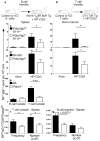PD-1 regulates germinal center B cell survival and the formation and affinity of long-lived plasma cells
- PMID: 20453843
- PMCID: PMC2874069
- DOI: 10.1038/ni.1877
PD-1 regulates germinal center B cell survival and the formation and affinity of long-lived plasma cells
Abstract
Memory B and plasma cells (PCs) are generated in the germinal center (GC). Because follicular helper T cells (T(FH) cells) have high expression of the immunoinhibitory receptor PD-1, we investigated the role of PD-1 signaling in the humoral response. We found that the PD-1 ligands PD-L1 and PD-L2 were upregulated on GC B cells. Mice deficient in PD-L2 (Pdcd1lg2(-/-)), PD-L1 and PD-L2 (Cd274(-/-)Pdcd1lg2(-/-)) or PD-1 (Pdcd1(-/-)) had fewer long-lived PCs. The mechanism involved more GC cell death and less T(FH) cell cytokine production in the absence of PD-1; the effect was selective, as remaining PCs had greater affinity for antigen. PD-1 expression on T cells and PD-L2 expression on B cells controlled T(FH) cell and PC numbers. Thus, PD-1 regulates selection and survival in the GC, affecting the quantity and quality of long-lived PCs.
Conflict of interest statement
The authors have no conflicts of interest.
Figures







Comment in
-
Give and take in the germinal center.Nat Immunol. 2010 Jun;11(6):464-6. doi: 10.1038/ni0610-464. Nat Immunol. 2010. PMID: 20485272 No abstract available.
Similar articles
-
CD80 expression on B cells regulates murine T follicular helper development, germinal center B cell survival, and plasma cell generation.J Immunol. 2012 May 1;188(9):4217-25. doi: 10.4049/jimmunol.1102885. Epub 2012 Mar 26. J Immunol. 2012. PMID: 22450810 Free PMC article.
-
BCL6-Mediated Silencing of PD-1 Ligands in Germinal Center B Cells Maintains Follicular T Cell Population.J Immunol. 2019 Feb 1;202(3):704-713. doi: 10.4049/jimmunol.1800876. Epub 2018 Dec 19. J Immunol. 2019. PMID: 30567732
-
Germinal center selection and the development of memory B and plasma cells.Immunol Rev. 2012 May;247(1):52-63. doi: 10.1111/j.1600-065X.2012.01124.x. Immunol Rev. 2012. PMID: 22500831 Review.
-
Deficiency in TNFRSF13B (TACI) expands T-follicular helper and germinal center B cells via increased ICOS-ligand expression but impairs plasma cell survival.Proc Natl Acad Sci U S A. 2012 Sep 18;109(38):15401-6. doi: 10.1073/pnas.1200386109. Epub 2012 Sep 4. Proc Natl Acad Sci U S A. 2012. PMID: 22949644 Free PMC article.
-
Germinal center B and follicular helper T cells: siblings, cousins or just good friends?Nat Immunol. 2011 Jun;12(6):472-7. doi: 10.1038/ni.2019. Nat Immunol. 2011. PMID: 21739669 Review.
Cited by
-
Distinct cellular pathways select germline-encoded and somatically mutated antibodies into immunological memory.J Exp Med. 2012 Oct 22;209(11):2079-97. doi: 10.1084/jem.20120127. Epub 2012 Oct 1. J Exp Med. 2012. PMID: 23027924 Free PMC article.
-
Human immunology and immunotherapy: main achievements and challenges.Cell Mol Immunol. 2021 Apr;18(4):805-828. doi: 10.1038/s41423-020-00530-6. Epub 2020 Sep 2. Cell Mol Immunol. 2021. PMID: 32879472 Free PMC article. Review.
-
Enhanced IgG4 production by follicular helper 2 T cells and the involvement of follicular helper 1 T cells in the pathogenesis of IgG4-related disease.Arthritis Res Ther. 2016 Jul 13;18:167. doi: 10.1186/s13075-016-1064-4. Arthritis Res Ther. 2016. PMID: 27411315 Free PMC article.
-
A case report of steroid-refractory bullous pemphigoid induced by immune checkpoint inhibitor therapy.Front Immunol. 2023 Jan 4;13:1068978. doi: 10.3389/fimmu.2022.1068978. eCollection 2022. Front Immunol. 2023. PMID: 36685586 Free PMC article.
-
Humanized Mice as an Effective Evaluation System for Peptide Vaccines and Immune Checkpoint Inhibitors.Int J Mol Sci. 2019 Dec 16;20(24):6337. doi: 10.3390/ijms20246337. Int J Mol Sci. 2019. PMID: 31888191 Free PMC article. Review.
References
-
- Joshi NS, Kaech SM. Effector CD8 T cell development: a balancing act between memory cell potential and terminal differentiation. J Immunol. 2008;180:1309–1315. - PubMed
-
- Han S, et al. Cellular interaction in germinal centers. Roles of CD40 ligand and B7-2 in established germinal centers. Journal of Immunology. 1995;155:556–567. - PubMed
-
- Jacob J, Kelsoe G, Rajewsky K, Weiss U. Intraclonal generation of antibody mutants in germinal centres. Nature. 1991;354:389–392. - PubMed
Publication types
MeSH terms
Substances
Grants and funding
LinkOut - more resources
Full Text Sources
Other Literature Sources
Molecular Biology Databases
Research Materials
Miscellaneous

